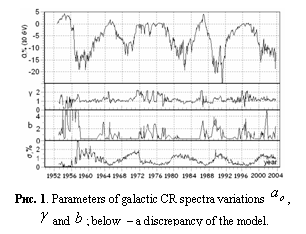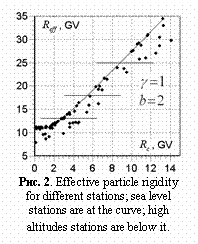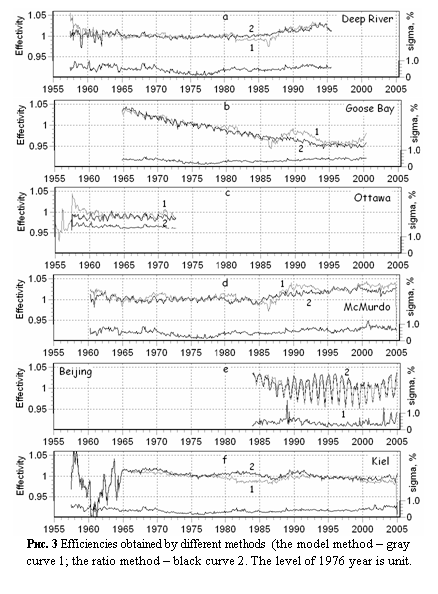29th International
Cosmic Ray Conference Pune (2005) 00,
101-104
Estimate of long-term detector stability of the worldwide neutron monitor network
Belov A., Gushchina R., Eroshenko E., Ivanus D., Yanke V.
Institute of Terrestrial Magnetism, Ionosphere and
Radio Wave Propagation RAS (IZMIRAN),
Results of continuous monitoring of cosmic rays
(CR) by the neutron monitor (NM) network are the experimental basement for a
large number of papers studying CR variations. The problem of long-term stability of
NM detectors is extremely important. In this work two independent methods for estimate of the long-term
stability of NM are used. Quantitative estimates are obtained for detectors
operating more than one solar cycle.
1. Introduction
More than 50 years researchers have such a powerful
instrument as a worldwide NM network. The purpose of this work is to determine
a data quality of each station. This problem was considered already [1]. In
order to estimate quantitatively a data quality one need some standard.
Arbitrary unjustified approach is used, when some “reliable” station is adopted
as such a standard. A number of stations have a reputation of “reliably”
working, but it is difficult to use them as the standard, because each station
is sensitive to a particular part of the CR spectrum.
Here we use the model of CR variations as the standard. A discrepancy with the
model for a particular station we describe by the data quality of this station.
Surely this approach has its own disadvantages since a construction of adequate
model is a complex problem itself. But this problem is resolved by the method
of successive approximations, if the model for corresponding changes is rather
succeeded describing CR variations in the heliosphere for fifty years of the
observations. We have elaborated the second independent method
estimating a stability of the station operation, which is called the method of
ratios. In this method a given set of stations (with nearly equal effective
rigidities of registered particles![]() ) is divided
into groups of “reliably” and “non-reliably” working by the elaborated
algorithm. In this case a group of stations having similar variations and
defined as “reliably” working determines the standard, moreover they should be
in majority. This method allows determining an efficiency of each station and
an accuracy of this estimate. Each method has its own advantages and
limitations, but basing on both of them it is possible to get reliable
quantitative estimates of long-term detector stability for the worldwide NM
network. The analysis has been performed basing of monthly average values
obtained by averaging of hourly data published in [2].
) is divided
into groups of “reliably” and “non-reliably” working by the elaborated
algorithm. In this case a group of stations having similar variations and
defined as “reliably” working determines the standard, moreover they should be
in majority. This method allows determining an efficiency of each station and
an accuracy of this estimate. Each method has its own advantages and
limitations, but basing on both of them it is possible to get reliable
quantitative estimates of long-term detector stability for the worldwide NM
network. The analysis has been performed basing of monthly average values
obtained by averaging of hourly data published in [2].
2 Model method
102 A.V. Belov et al.
In [3] a variant of the global survey was elaborated
for studying of long-term variations. The analysis was performed by using
monthly average data of NM’s (45 stations), stratospheric (3 stations) and
ionization chamber (2 stations) observations. The observed variation ![]() can be
expressed as
can be
expressed as ![]() +
+ ![]() where
where ![]() - a spectrum
of isotropic variations, and a discrepancy reflects some problems of the model
and possible instrumental variations. The coupling coefficients
- a spectrum
of isotropic variations, and a discrepancy reflects some problems of the model
and possible instrumental variations. The coupling coefficients ![]() are adopted
from [4]. The model assumes three parametric spectrum of variations, which is
given by
are adopted
from [4]. The model assumes three parametric spectrum of variations, which is
given by ![]() ; parameter changes are within
; parameter changes are within ![]() and
and ![]() , if R is
given in GV. The approximation of three parameters for galactic CR spectra
variations is suitable for description of long-term spectra variations in the
range of 5-50 GV as shown in [3]. Only a few stations continuously operate
during 5 cycles of SA. Some stations were closed, another open. In order to
account a varied number of stations and make an influence of possible detector
drift for so long time the spectra were calculated for several base periods. As
a result all variations have been determined relatively the base period of
1976. Fig. 1 shows the obtained parameters of galactic CR spectra variations
, if R is
given in GV. The approximation of three parameters for galactic CR spectra
variations is suitable for description of long-term spectra variations in the
range of 5-50 GV as shown in [3]. Only a few stations continuously operate
during 5 cycles of SA. Some stations were closed, another open. In order to
account a varied number of stations and make an influence of possible detector
drift for so long time the spectra were calculated for several base periods. As
a result all variations have been determined relatively the base period of
1976. Fig. 1 shows the obtained parameters of galactic CR spectra variations ![]() ,
, ![]() è
è ![]() . The bottom
panel presents average square deviations of experimental data and the model,
which allows estimating an appropriateness of the model proposed.
. The bottom
panel presents average square deviations of experimental data and the model,
which allows estimating an appropriateness of the model proposed.

3 Method of ratios
 This
method was elaborated for internal control of data quality of CR ground based
detectors. During the earlier stage of network creation a transfer from the
2-section IGY monitor (where it was possible ascertaining instrument variations
only) to the 3-section NM64 neutron monitor, when a variation comparison between
different, but one type sections, allows to select a defective section. Modern
methods of internal control are based on dividing of a detector into maximal
possible number of identical and independent elementary detectors (this is a
number of counters in a case of NM). This approach allows determining a
relative efficiency of each elementary detector, i.e. this method provides a
tool for permanent control of data quality [5]. The detector efficiency can be
defined as a number, by which should be divided the observed count rate to
remove variations associated with changes of the detector itself. The method of
ratios was adopted for the analysis of long-term detector stability of the NM
network. A condition of applicability of the method for analysis of long-term
detector stability is forming groups of stations with very close
characteristics, for instance, similar effective rigidities of registered
particles. We considered 4 groups of stations with effective rigidities of
registered particles <13, 13-18, 18-25, >25 GV (Fig. 2). It is an
advantage of this approach that it is not model dependent. Its disadvantage is
a necessity to consider group of stations with close effective rigidities of
registered particles.
This
method was elaborated for internal control of data quality of CR ground based
detectors. During the earlier stage of network creation a transfer from the
2-section IGY monitor (where it was possible ascertaining instrument variations
only) to the 3-section NM64 neutron monitor, when a variation comparison between
different, but one type sections, allows to select a defective section. Modern
methods of internal control are based on dividing of a detector into maximal
possible number of identical and independent elementary detectors (this is a
number of counters in a case of NM). This approach allows determining a
relative efficiency of each elementary detector, i.e. this method provides a
tool for permanent control of data quality [5]. The detector efficiency can be
defined as a number, by which should be divided the observed count rate to
remove variations associated with changes of the detector itself. The method of
ratios was adopted for the analysis of long-term detector stability of the NM
network. A condition of applicability of the method for analysis of long-term
detector stability is forming groups of stations with very close
characteristics, for instance, similar effective rigidities of registered
particles. We considered 4 groups of stations with effective rigidities of
registered particles <13, 13-18, 18-25, >25 GV (Fig. 2). It is an
advantage of this approach that it is not model dependent. Its disadvantage is
a necessity to consider group of stations with close effective rigidities of
registered particles.
4. Discussion and conclusions
Estimate of long-term … 103
 A
detailed coincidence of efficiencies found by the two methods supports both of
them. The analysis of efficiencies shows that a constant drift by about
A
detailed coincidence of efficiencies found by the two methods supports both of
them. The analysis of efficiencies shows that a constant drift by about ![]() 0.1 %/year
is observed for many stations during the whole or, at least, rather long period
of observations (Fig. 3a). The largest drift, of about -0.4 %/year, is for data
of the
0.1 %/year
is observed for many stations during the whole or, at least, rather long period
of observations (Fig. 3a). The largest drift, of about -0.4 %/year, is for data
of the
104 A.V.
Belov et al.
If periodic variations are rather easy separated and corrected than in a case of long-term instrument drift it is very difficult. The largest error in data (up to 0.1 %/year) appears due to the pressure drift. A usage of constant barometric coefficient leads to a false 11-year wave with amplitude up to 0.1 %. Large sporadic changes of efficiencies can be caused, at least, by two reasons. The first is a charge leakage (micro breakdown) along high voltage circuit. The second is low stability of high voltage supply (or malfunction of stabilization scheme). Besides, for some high altitudes stations the snow effect is very important. This effect may lead to a total distortion of variations.
The above discussion allows us
to conclude:
1. The model method, when a discrepancy between the modeled and observed variations for each is attributed to data quality, provides a possibility qualitatively and quantitatively verifying long-term stability of each station from the network. A suitability of the model used for CR variations as well as a quality of data sewing between different epochs determines an accuracy of the method.
2. The method of ratios is model
independent. In this case for a group of stations with similar effective energy
a long-term drift is determined for each station. However not for all energy
intervals it is possible to find more than 6 identical stations working
simultaneously; this is a disadvantage of such approach.
3. The coincidence in details between
efficiencies found by two methods shows a possibility to use both methods.
Besides our model of variations describes rather well CR modulation for all 50
years of observations, excluding the region of small rigidities. The South Pole
station is an example.
4. For the best stations (about 10) the
drift is about 0.04 %/year and comparable with amplitude variation obtained
using all data and presented in Fig. 1; this value is comparable with error and
equal ~ -0.01 %/year for the period of 1976 - 1997.
5. A stability of about 30 stations working
several tens of years is better that 2 % for the whole period of observations.
However sporadic changes of the efficiency is characteristic for many of them.
The characteristic drift is about ![]() 0.1 %/year.
0.1 %/year.
6. For many stations (about 40) the data
drift is on the second plan, the data quality is determined by numerous
sporadic changes.
7. The whole analyses of the network of CR stations is presented in
[6].
4.
Acknowledgements
This work is partly supported by Russion
FBR grants 03-07-90389, 04-02-16763, 05-02-17251 and Program BR of the
Presidium RAS “Neutrino Physics” and also http://cr0.izmiran.rssi.ru/ThankYou/main.htm.
References
[1] A.V. Belov et.al. Geomagn. and aeron. 28, 550,
(1988).
“The data of many years cosmic ray observations and
efficiency of cosmic ray registration by neutron monitors during 1953-1991”,
Preprint IZMIRAN,
[2] ftp://cr0.izmiran.rssi.ru/COSRAY!/FTP_NM/C/.
[3] A.V. Belov et.al.
Geomagn. and
aeron. 38, 131, (1998).
[4] T.M.
Alexanjan et.al. Izv. Akad. Nauk. Ser. Fiz. 46, 1689, (1982).
[5] A.V.
Belov et.al. “Cosmic rays”.
See also http://cr0.izmiran.rssi.ru/STATION/editor.htm.
[6] http://cr0.izmiran.rssi.ru/LongTimeVarCR/LongTimeStab/main.htm
[7] A.V.
Belov et.al. Proc. 24th
ICRC. 4, 1141, (1995).